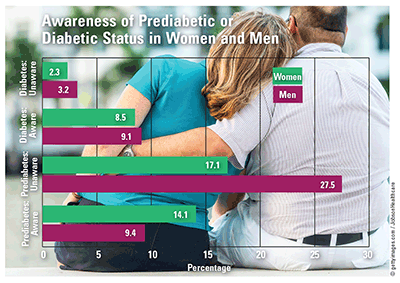US Pharm. 2018;43(10):48.
After the American Diabetes Association adjusted the criterion for prediabetes from 110–125 mg/dL to 100–125 mg/dL, an additional 45.9 and 70.6 million adults, respectively, were at risk for developing type 2 diabetes in 2003 (16.1 million) and 2010 (86.7 million). Based on screening for hemoglobin A1C (HbA1C), 34.1 million adults (14.2%) were prediabetic (range: 5.7%-6.5%), and when these data were combined with those for fasting plasma glucose (FPG), the prevalence increased to 77.3 million (32.2%).

Prevalence and Awareness: In 2015, based on FPG or HbA1C screening, 84.1 million adults (33.9%) had prediabetes, but only 11.6% were aware of it. The highest prevalence (23.1 million) was in persons aged 65 years and older (48.3%); the lowest was in those aged 18 to 44 years (23.7%). Of prediabetic adults, 15.5% of those aged 18 to 44 years, 28% of those aged 45 to 64 years, and 34.2% of those aged 65 years and older were unaware of having the condition. Prediabetes occurred in 39.5 million women (31.1%) and 44.5 million men (36.9%), but only 14.1% and 9.4%, respectively, were aware of it. The more education an adult had (less than high school, high school, more than high school), the lower the prevalence (37.6%, 37%, 30.4%). Those with less than a high school education had the least awareness of having prediabetes (9.3%), 12.4% of those with a high school education were aware of it, and 10.4% of those with more than a high school education were aware of it.
Progression: Annually, about 5% to 10% of prediabetic adults progress to diabetes. According to the National Institute of Diabetes and Digestive and Kidney Diseases, most adults with prediabetes will progress to type 2 diabetes within 10 years if they do not make lifestyle modifications. Without intervention, an estimated 37% of prediabetic adults could develop diabetes in 4 years, but if they undertake a lifestyle-intervention program, the rate would drop to 20%.
Risk Factors: Lifestyle risk factors for prediabetes include overweight/obesity and physical inactivity. Of prediabetic adults who reduced their fat/caloric intake, rates were similar in those who were married, widowed, never-married, and divorced/separated. In 2015, according to the CDC, 40.8% of adults were physically inactive—i.e., performed less than 10 minutes of moderate or vigorous activity per week during leisure, transportation, or work. Between 2005 to 2008 (44.6%) and 2011 to 2012 (54.7%), there was a 22.6% increase in physical activity (preventive behavior) among prediabetic adults. Although 87.5% of adults were overweight or obese, 56.5% of prediabetic adults met or exceeded the 2020 target for losing weight, which was a 2.7% change from 2011 to 2012.
To comment on this article, contact rdavidson@uspharmacist.com.





